
Hyundai Tucson Owners Manual
Power brakesDriving your vehicle / Braking system / Power brakes
Your vehicle has power-assisted brakes that adjust automatically through normal usage.
If the engine is not running or is turned off while driving, the power assist for the brakes will not work.
You can still stop your vehicle by applying greater force to the brake pedal than typical. The stopping distance, however, will be longer than with power brakes.
When the engine is not running, the reserve brake power is partially depleted each time the brake pedal is applied. Do not pump the brake pedal when the power assist has been interrupted.
Pump the brake pedal only when necessary to maintain steering control on slippery surfaces.
WARNING
Take the following precautions:
- Do not drive with your foot resting on the brake pedal. This will create abnormal high brake temperatures, excessive brake lining and pad wear, and increased stopping distances.
- When descending a long or steep hill, shift to a lower gear and avoid continuous application of the brakes. Applying the brakes continuously will cause the brakes to overheat and could result in a temporary loss of braking performance.
- Wet brakes may impair the vehicleŌĆÖs ability to safely slow down; the vehicle may also pull to one side when the brakes are applied. Applying the brakes lightly will indicate whether they have been affected in this way. Always test your brakes in this fashion after driving through deep water. To dry the brakes, lightly tap the brake pedal to heat up the brakes while maintaining a safe forward speed until brake performance returns to normal. Avoid driving at high speeds until the brakes function correctly.
Disc brakes wear indicator
When your brake pads are worn and new pads are required, you will hear a high pitched warning sound from your front or rear brakes. You may hear this sound come and go or it may occur whenever you depress the brake pedal.
Please remember some driving conditions or climates may cause a brake squeal when you first apply (or lightly apply) the brakes. This is normal and does not indicate a problem with your brakes.
CAUTION
To avoid costly brake repairs, do not continue to drive with worn brake pads.
✽ NOTICE
Always replace brake pads as complete front or rear axle sets.
Parking brake
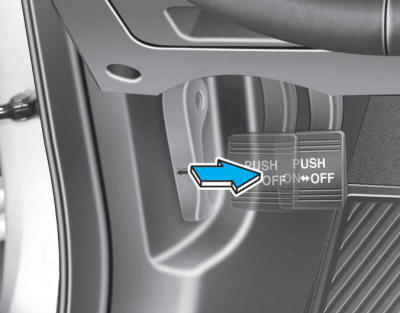
Always set the parking brake before leaving the vehicle, to apply:
■ Foot type
Firmly depress the brake pedal. Depress the parking brake pedal down as far as possible.
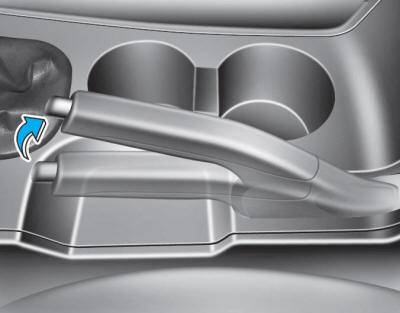
■ Hand type
Firmly depress the brake pedal. Pull up the parking brake lever as far as possible.
WARNING
To reduce the risk of SERIOUS INJURY or DEATH, do not operate the parking brake while the vehicle is moving except in an emergency situation. It could damage the brake system and lead to an accident.
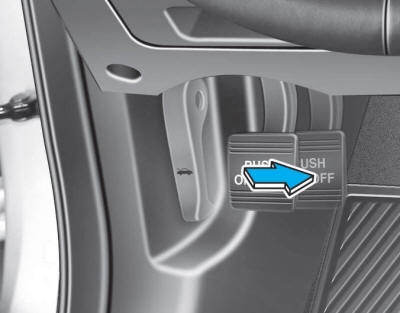
To release:
■ Foot type
Firmly depress the brake pedal. Depress the parking brake pedal down and it will release automatically.
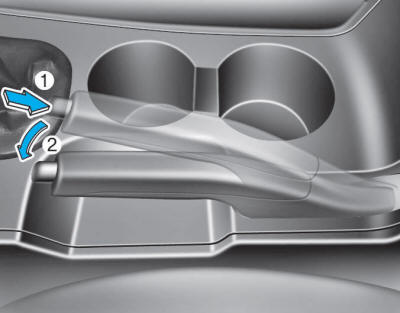
■ Hand type
Firmly depress the brake pedal. Slightly pull up the parking brake lever.
While pressing the release button (1), lower the parking brake (2).
If the parking brake does not release or does not release all the way, have the system checked by an authorized HYUNDAI dealer.
WARNING
- Whenever leaving the vehicle or parking, always come to a complete stop and continue to depress the brake pedal. Move the shift lever into the P (Park) position, then apply the parking brake, and place the ignition switch in the LOCK/OFF position. Vehicles with the parking brake not fully engaged are at risk for moving inadvertently and causing injury to yourself or others.
- NEVER allow anyone who is unfamiliar with the vehicle to touch the parking brake. If the parking brake is released unintentionally, serious injury may occur.
- Only release the parking brake when you are seated inside the vehicle with your foot firmly on the brake pedal.
CAUTION
- Do not apply the accelerator pedal while the parking brake is engaged. If you depress the accelerator pedal with the parking brake engaged, warning will sound. Damage to the parking brake may occur.
- Driving with the parking brake on can overheat the braking system and cause premature wear or damage to brake parts. Make sure the parking brake is released and the Brake Warning Light is off before driving.
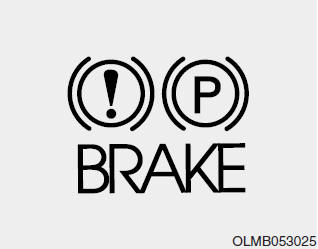
Check the Parking Brake Warning Light by placing the ignition switch to the ON position (do not start the engine).
This light will be illuminated when the parking brake is applied with the ignition switch in the START or ON position.
Before driving, be sure the parking brake is released and the Brake Warning Light is OFF.
If the Parking Brake Warning Light remains on after the parking brake is released while engine is running, there may be a malfunction in the brake system. Immediate attention is necessary.
If at all possible, cease driving the vehicle immediately. If that is not possible, use extreme caution while operating the vehicle and only continue to drive the vehicle until you can reach a safe location.






